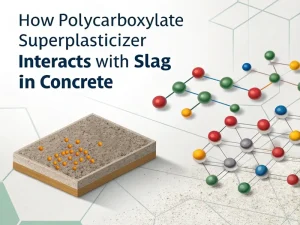Blog

SNF (Sulfonated Naphthalene Formaldehyde) and PCE (Polycarboxylate Superplasticizer) are two commonly used high-efficiency water-reducing agents in the construction industry.
Know more about SNF, please reader this Sulfonated Naphthalene Formaldehyde>>
Know more about PCE, please reader this Polycarboxylate Superplasticizer>>
SNF is a condensation product of naphthalene sulfonic acid and formaldehyde. It is composed of a naphthyl molecular structure with sulfonic acid groups. Sulfonate groups play a crucial role in the performance of cement particles by providing anionic sites for interaction.
PCE is a more complex polymer. It usually comprises a leading acrylic or methacrylic acid unit chain with long polyethylene glycol (PEG) side chains attached. The unique combination of the central and side chains endows PCE with exceptional properties.
SNF has a relatively rigid and linear molecular structure. The naphthalene ring provides a certain degree of rigidity, and the sulfonic acid groups are distributed along the chain. This structure gives SNF a specific shape that affects its adsorption and dispersion behavior on cement particles.
Due to PEG side chains, PCE has a more flexible and branched molecular structure. Side chains can extend from the main chain to form a three-dimensional structure. This branching structure gives PCE a more substantial steric hindrance effect, which is beneficial for maintaining the dispersion of cement particles.
SNF mainly works through electrostatic repulsion. When added to cement slurry, the sulfonic acid groups on SNF molecules adsorb onto the surface of cement particles, giving them a negative charge. This leads to mutual repulsion of cement particles, resulting in increased dispersion and fluidity of the cement slurry.
PCE operates through a combination of electrostatic repulsion and steric hindrance. The carboxylate groups on the PCE main chain adsorb onto cement particles, providing initial electrostatic repulsion. In addition, long PEG side chains form a spatial barrier around cement particles. When particles approach each other, side chains prevent them from aggregating and maintain a high level of dispersion.
SNF generally has moderate water-reducing ability, typically within the 15% -25% range. It can effectively reduce the moisture content in concrete mixtures while maintaining a certain degree of workability.
PCE has a higher water reduction capacity, typically reaching 25% -40% or even higher. This allows for producing high-strength and high-performance concrete with lower water-cement ratios.
SNF has relatively poor slump retention. The concrete slump may significantly decrease, especially in hot weather or long transportation times.
PCE exhibits excellent slump retention. It can maintain the workability of concrete for a more extended period, reducing the need for additional water or admixtures during construction.
Concrete containing SNF exhibits relatively normal strength development. It can achieve satisfactory compressive strength, but the early strength growth may not be as fast as PCE.
PCE is beneficial for improving concrete’s early and long-term strength. PCE’s better dispersion of cement particles leads to more complete hydration reactions, resulting in higher compressive and flexural strength.
Concrete made with SNF has moderate durability. It can resist normal environmental conditions, but compared to PCE-modified concrete, it may be more prone to cracking and deterioration over time.
PCE improves the durability of concrete by reducing porosity and improving microstructure. Concrete is more resistant to water infiltration, chemical erosion, and freeze-thaw cycles.
SNF may have a relatively high impact on the environment. Its production process may involve the use of organic solvents and chemicals that may cause pollution. In addition, the waste generated by concrete containing SNF may have a certain impact on the environment.
PCE is generally considered more environmentally friendly. It has a lower alkali content and can be formulated with more sustainable raw materials. The waste generated by PCE-modified concrete is also easier to handle. It has a minor environmental impact.
Compared to PCE, SNF has relatively lower production costs. This makes SNF a more economical choice in specific applications where performance requirements are not very high.
Due to its complex production process and high-quality raw materials, PCE has a higher price. However, its superior performance in many high-performance concrete applications often proves that higher costs are reasonable.
In summary, SNF and PCE have advantages and disadvantages, and their choice depends on specific project requirements, budget constraints, and environmental considerations.

How Polycarboxylate Polyether Monomer Affect Concrete Performance
Blog How Polycarboxylate

How Polycarboxylate Superplasticizer Interacts With Slag In Concrete
Blog How Polycarboxylate